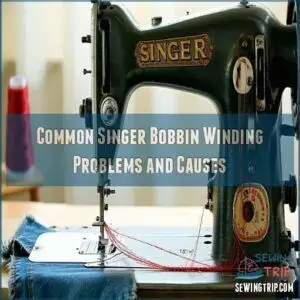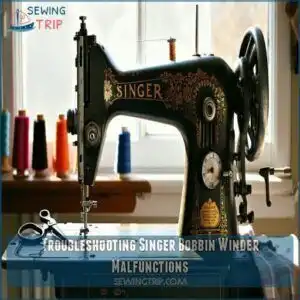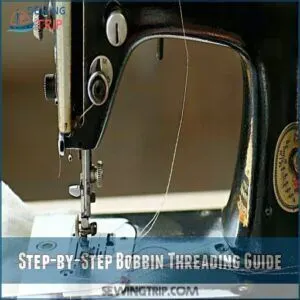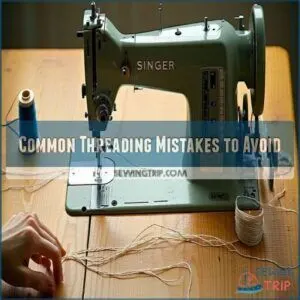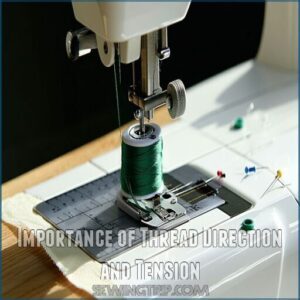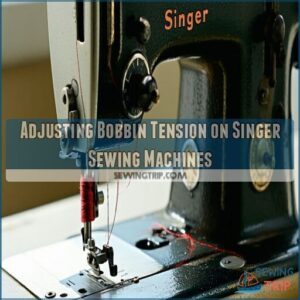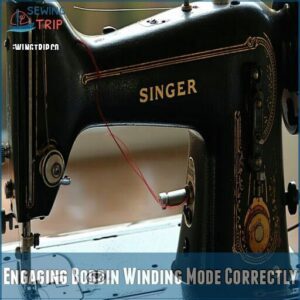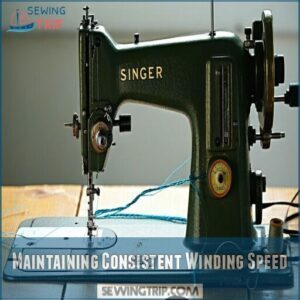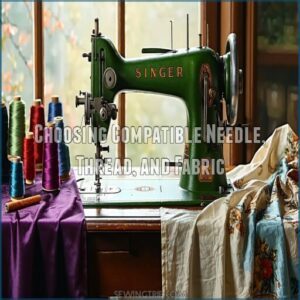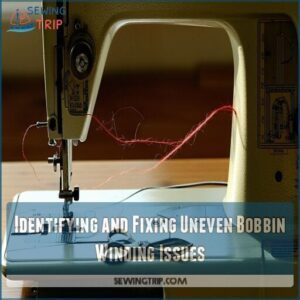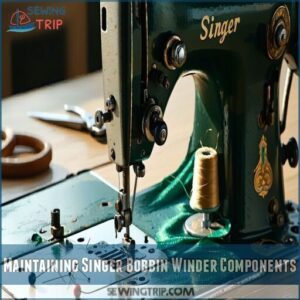This site is supported by our readers. We may earn a commission, at no cost to you, if you purchase through links.
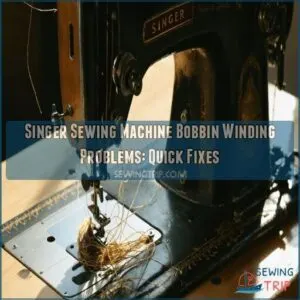 Singer sewing machine bobbin winding problems got you in a twist? You’re not alone!
Singer sewing machine bobbin winding problems got you in a twist? You’re not alone!
Common culprits include a jammed bobbin winder spindle (check for stray threads!), lint buildup (a quick brush works wonders), a worn-out tire (easy fix!), or a broken spring.
Sometimes, the hand wheel itself is the issue. For persistent singer sewing machine bobbin winding problems, look at the hand wheel’s movement and lubrication.
Ready to unravel these mysteries and get back to smooth sewing? There’s more to discover.
Table Of Contents
- Key Takeaways
- Common Singer Bobbin Winding Problems and Causes
- Troubleshooting Singer Bobbin Winder Malfunctions
- Proper Bobbin Threading Techniques for Singer Machines
- Adjusting Bobbin Tension on Singer Sewing Machines
- Resolving Thread Jamming in Singer Bobbin Area
- Identifying and Fixing Uneven Bobbin Winding Issues
- Maintaining Singer Bobbin Winder Components
- Selecting Appropriate Thread for Singer Bobbin Winding
- Advanced Bobbin Winding Techniques for Singer Models
- When to Seek Professional Help for Bobbin Problems
- Frequently Asked Questions (FAQs)
- Conclusion
Key Takeaways
- You’ll likely encounter common bobbin winding problems like a jammed spindle, lint buildup, a worn tire, or a broken spring. Regular maintenance and cleaning can prevent these issues. Check your hand wheel’s movement and lubrication for persistent problems.
- You can troubleshoot malfunctions by adjusting the bobbin winder mechanism, replacing faulty components, cleaning and lubricating parts, and checking bobbin compatibility. Consider a stand-alone bobbin winder as an alternative.
- You’ll need proper bobbin threading techniques, including a step-by-step guide and avoiding common mistakes. Selecting the correct bobbin for your model and understanding thread direction and tension are crucial. Adjust your bobbin tension with a gauge and fine-tune it for different fabrics.
- You can resolve thread jams by correctly engaging the bobbin winder, securing the thread tail, and maintaining consistent winding speed. Choose compatible needles, thread, and fabric. Identify and fix uneven winding by adjusting tension and guiding the thread smoothly. Inspect and maintain your Singer bobbin winder components for wear and tear. Select appropriate thread weight and quality, and store it properly. Learn advanced techniques for specific projects and thread types. Seek professional help for severe damage, persistent tension issues, or unexplained malfunctions.
Common Singer Bobbin Winding Problems and Causes
You’ll likely encounter a few common bobbin winding problems with your Singer sewing machine. This section explains those issues and their causes, so you can quickly get back to sewing.
Bobbin Winder Spindle Stuck or Stiff
A stuck bobbin winder spindle? A stiff spindle can stop your sewing projects fast. This is often caused by a thread jam.
- Check for stray threads: Look under the needle plate and around the bobbin case.
- Inspect the take-up lever: It might be causing the bobbin winder spindle to stick.
- Don’t give up! A little patience will get your spindle spinning and you back to sewing.
Lint Buildup in Bobbin Winder Area
That pesky lint is gunning for your Singer’s bobbin winder, aiming to slow down your creative flow. Left unchecked, lint buildup can lead to a full-blown bobbin crisis.
Keep your Singer humming smoothly with regular maintenance. Grab a small brush and sweep away the lint—it’s like giving your machine a mini-makeover.
- Keep a dedicated brush in your sewing kit for quick cleanups.
- Regularly remove lint to prevent tangles and keep your winder happy.
- A clean bobbin winder means smoother sewing and fewer headaches, ensuring a happy sewing experience.
Worn Out Bobbin Winder Tire
That rubber wheel on your bobbin winder might be ready for retirement! It’s the unsung hero of smooth winding, but over time, it can wear down, leaving you with less-than-perfect results.
Keep an eye out for these signs:
| Warning Sign | Description |
|---|---|
| Uneven Winding | Your bobbin thread isn’t winding evenly, resulting in sloppy stitches. |
| Lack of Grip | The bobbin winder struggles to grip the thread, leading to slippage. |
| Aging | Noticeable wear and tear on the tire, indicating it’s seen better days. |
A worn-out bobbin winder tire is a common issue with an easy fix. Replacing it’s a quick job, and you’ll be back to seamless sewing in no time, with perfect results and a smooth winding experience.
Broken Bobbin Winder Spring
A broken bobbin winder spring brings your project to a screeching halt. This issue prevents the winder from retracting, leaving you hanging.
Here’s how to tackle it:
- Identify: Confirm the issue. A broken spring means the winder won’t retract.
- DIY Fix: Try a quick fix. You may be able to repair or replace the spring yourself.
- Singer Support: Consult Singer resources for guidance on spring replacement and winder repair.
- Consider Alternatives: Explore stand-alone bobbin winders to bypass built-in winder issues.
Let’s get that winder humming again!
Hand Wheel Not Moving Freely
If your Singer sewing machine’s hand wheel is stuck, your bobbin winder might be affected. Check if old oil is gumming up the wheel, preventing free movement. This is a common Singer bobbin problem.
Sometimes, wheel alignment or spindle repair is needed.
For persistent bobbin winding issues or a bobbin not winding correctly, consult your Singer sewing machine manual or a professional.
Troubleshooting Singer Bobbin Winder Malfunctions
If your Singer sewing machine is acting up, don’t panic. We’ll guide you through troubleshooting common bobbin winder malfunctions, so you can quickly get back to creating masterpieces.
Adjusting The Bobbin Winder Mechanism
A smooth-running bobbin winder is key to your sewing success.
Singer sewing machine bobbin winding problems often stem from a misaligned bobbin winder mechanism.
To fix this, locate your machine’s bobbin winder tension adjustment screw and make minor tweaks.
Calibrate the winder by ensuring the bobbin sits straight and winds evenly.
Clean the mechanism and, if needed, repair the spindle.
These steps will have you back to sewing in no time.
Replacing Faulty Bobbin Winder Components
Is your Singer sewing machine acting up? It might be time to swap out those worn-out parts.
Here’s a quick guide to get you back on track:
- Identify the issue: Is it the rubber tire?
- Source quality replacements.
- Consider the lifespan of components—are they due for a change?
Keep things clean: A tidy bobbin winder is an efficient one. Regular maintenance also involves checking for bobbin winding problems to maintain smooth operation.
Now you’re ready to tackle that repair!
Cleaning and Lubricating Bobbin Winder Parts
Keeping your Singer sewing machine in tip-top shape is easy with regular bobbins maintenance.
First, banish that lint buildup with a quick sweep of a tiny brush.
Next, apply a drop of sewing machine oil to the bobbin winder shaft and mechanism.
This simple lubrication guarantees smooth sailing and consistent, even bobbin winding.
So, keep your machine happy with this quick fix!
Checking Bobbin Quality and Compatibility
Don’t let bobbin compatibility be an afterthought.
Size matters, so make sure you’re using the right bobbin size, like Class 15.
Brand reputation is important, too—you don’t want to skimp on quality.
Material differences can also impact performance, so pay attention to the type of bobbin your machine requires.
Follow the bobbin winding instructions to avoid issues, and always check thread compatibility with your bobbin to sidestep those frustrating tangles, ensuring a smooth experience with the right thread compatibility.
Considering Stand-Alone Bobbin Winder Options
A standalone bobbin winder is a handy tool for any sewer’s arsenal. These devices efficiently manage thread, offering consistent tension and speed.
Pfaff, Viking, Simplicity, and Singer offer a range of options with features like auto-shutoff. These portable, compact winders are a great alternative to built-in bobbin winders, especially for frequent sewers.
Compare and choose one that suits your singer sewing machine and bobbin type for seamless stitching. For best results, consider using a portable bobbin winder to simplify your sewing process.
Proper Bobbin Threading Techniques for Singer Machines
Threading a bobbin can be tricky, but it’s an essential step to achieving smooth, even stitches.
This section will guide you through the proper techniques for threading a Singer machine bobbin, helping you avoid common mistakes and achieve sewing success.
Step-by-Step Bobbin Threading Guide
Thread jams and bobbin winding issues are a thing of the past! With your Singer sewing machine manual as your guide, you can easily master the art of bobbin threading.
Here’s a step-by-step breakdown:
- Place your thread spool on the spindle, ensuring it winds in the correct direction.
- Thread the bobbin case correctly.
- Check your bobbin type and thread tension—matching these is key to smooth sewing.
- Wind the thread onto the bobbin.
- Pop the bobbin into your Singer, and you’re ready to sew!
Common Threading Mistakes to Avoid
Now that you’ve got the basics down, let’s sidestep some common threading trip-ups.
First, mind your thread’s direction—wrong moves mess with tension. Check thread quality matches your fabric, and peek at bobbin tension.
Keep tension discs clean; tangles hate tidy tension discs. Properly adjusting the upper thread tension is also important for smooth operation.
Dodging these threading blunders keeps your Singer sewing machine humming happily along, avoiding bobbin winding woes.
Selecting The Correct Bobbin for Your Model
Mastering the variety of bobbin types can feel like finding a needle in a haystack. Your Singer sewing machine’s success depends on choosing the right bobbin size and material for your specific model.
- Check your machine’s manual to identify the correct Class bobbins (15, 15J, 66, or others)
- Select metal bobbins for heavy-duty work, plastic for lightweight projects
- Verify bobbin compatibility by comparing dimensions with your existing ones
Importance of Thread Direction and Tension
Proper thread direction and bobbin winding tension are essential for even, snag-free stitches.
For consistent tension and smooth operation:
- Verify your thread unwinds counter-clockwise from the spool. This proper thread direction prevents tangles.
- Guide the thread through the tension discs for balanced winding tension.
- Test your bobbin tension and thread compatibility with a short stitch. If the thread bunches or breaks, adjust your bobbin winding tension or check for thread tension issues.
Troubleshooting Bobbin Threading Issues
First, double-check your bobbin placement and winding direction. Then, verify your thread path is clear, paying close attention to the thread guides.
Verify correct bobbin tension for your thread type.
If your Singer sewing machine bobbin still gives you bobbin winding problems, re-thread, checking thread tension. Sometimes, the simplest solution is best!
Adjusting Bobbin Tension on Singer Sewing Machines
You’ll learn how to adjust your Singer’s bobbin tension for smooth, even stitching. This involves finding the bobbin tension screw and making small adjustments to achieve the perfect thread flow.
Locating The Bobbin Tension Screw
Now that your bobbin is threaded, let’s find that elusive bobbin tension screw. It’s typically a small screw near the bobbin case, controlling your bobbin winding tension.
Look for a tiny screw on the side or front of the bobbin case assembly. Screw placement varies depending on your Singer model, so check your manual for the exact location of the bobbin tension screw.
Identifying the correct screw type is key for proper tension adjustment. This screw directly impacts your bobbin winding tension and overall stitch quality.
Accessing this screw allows you to fine-tune your bobbin tension, solving many Singer bobbin winding problems.
Using a Bobbin Tension Gauge
Using a bobbin tension gauge is like giving your Singer sewing machine a mini-tune-up.
This simple tool helps you fine-tune the tension for precision stitching.
Hook the bobbin thread onto the gauge, give it a gentle tug, and check if the tension reads between 190 and 220 mN.
It’s an easy fix for bobbin winding woes and gives you more control over your sewing projects.
Fine-Tuning Tension for Different Fabrics
A tension gauge is your secret weapon for mastering bobbin tension. It’s all about finding that sweet spot, and a tiny tweak can make a big difference!
For lightweight fabrics, ease up on the tension. For heavyweight fabrics, give it a little extra oomph.
This fine-tuning guarantees your stitches are flawless, no matter the fabric type. It’s like magic for stitch quality and tension control.
Balancing Upper and Lower Thread Tension
Now that you’ve handled fabric settings, let’s fine-tune your tension balance.
A harmonious thread tension is key. If your upper thread keeps breaking, your bobbin winding might be too tight. Too loose, and your stitches will be messy.
Proper thread tension adjustments are paramount for various fabrics.
Adjust the bobbin tension screw and the top tension dial. The right tension balance depends on your fabric and thread type, so troubleshoot until your stitches are perfect.
Testing and Verifying Tension Adjustments
After balancing your bobbin winder tension, sew a test seam. A proper tension check verifies adjustment results and reveals consistent winding.
Look for these signs of correct thread tension and bobbin winding tension:
- Balanced stitch quality
- Even winding thread
- No loops or puckers
- Consistent stitch formation
If your stitch quality isn’t perfect, revisit your bobbin winder tension or consult your machine’s manual.
Resolving Thread Jamming in Singer Bobbin Area
Is your Singer’s bobbin area a tangled mess?
You can easily fix thread jams by correctly engaging the bobbin winder, securing the thread tail, maintaining consistent winding speed, and keeping the area clean.
Engaging Bobbin Winding Mode Correctly
After adjusting your Bobbin tension, verify your Singer’s bobbin winding mode is correctly engaged. Double-check your bobbin placement and push the winder lever to the correct position. This engages the thread path for bobbin winding.
If your handwheel still spins, nudge the winder lever again. Controlling the winding speed helps, too.
Remember to disengage the winder once your singer bobbin winding is complete.
Proper Thread Tail Length and Securing
With bobbin winding mode engaged, secure the thread tail to prevent jams.
Leave a two-inch tail and tuck it into the bobbin’s notch. This secures the thread for initial winding, ensuring consistent tension and preventing tangles.
For a detailed guide, review this helpful sewing machine bobbin threading guide. This simple step helps avoid common bobbin winding problems, keeping your sewing machine bobbin happy.
Maintaining Consistent Winding Speed
Finding the right bobbin winding speed is a lot like finding your groove on the dance floor. Too fast or too slow, and you’ll step on your partner’s toes.
Verify your bobbin tension and machine settings if you’re winding too quickly or slowly. Make sure your bobbin type matches its intended use, and keep an eye on the process. With practice, you’ll master the rhythm and avoid those pesky sewing machine bobbin winding problems.
- Speed Control: Adjust winding speed for ideal thread flow.
- Thread Flow: Verify smooth, consistent winding with proper tension.
- Winding Technique: Focus on even, controlled winding.
- Tension Adjustment: Fine-tune tension for perfect harmony.
Cleaning Dust and Lint From Bobbin Area
You’ll prevent thread jams by cleaning dust and lint from the bobbin area regularly, using a soft brush or compressed air, to maintain smooth sewing machine operation.
This maintenance is crucial to maintain your Singer sewing machine’s performance, reducing singer sewing machine bobbin winding problems.
Through proper bobbin maintenance and lint cleaning, you can ensure optimal performance and minimize issues with your sewing machine.
Choosing Compatible Needle, Thread, and Fabric
You’re now ready to choose compatible needle, thread, and fabric.
Consider:
- Fabric Selection
- Thread Weight
- Needle Size
- Fabric Types
- Thread Quality to avoid bobbins winding problems on your Singer sewing machine, ensuring proper thread tension for smooth sewing.
Identifying and Fixing Uneven Bobbin Winding Issues
You’ll identify uneven bobbin winding issues by checking your thread tension and bobbin alignment.
By adjusting your bobbin winder tension and guiding the thread smoothly, you can fix uneven winding problems and get back to sewing efficiently.
Improper Threading Causing Uneven Winding
You’re troubleshooting singer sewing machine bobbin winding problems.
Check for improper threading causing uneven winding by verifying thread direction and using quality thread.
Consider these:
- Thread Tension
- Bobbin Alignment
- Winding Speed to maintain proper stitch quality and avoid bobbin winding too tight or too loose, ensuring proper stitch quality.
Adjusting Bobbin Winder Tension
Adjust the bobbin winder tension on your Singer sewing machine for consistent results.
Use a tension gauge and check for wear or loose parts. Quality thread provides smooth winding.
| Tension | Thread | Speed |
|---|---|---|
| Low | Thin | Fast |
| Med | Med | Med |
| High | Thick | Slow |
| Auto | Var | Adapt |
Guiding Thread for Smooth, Level Winding
To fix uneven bobbin winding, you control thread flow by setting the right thread tension and bobbin winder speed.
- Set thread tension
- Control speed
- Guide thread
These steps are crucial for even bobbin winding, and it is also important to choose quality materials to avoid bobbin winding problems.
Addressing Bobbin Winder Clutch Malfunctions
You tackle clutch malfunctions by loosening the clutch knob screw and checking the metal ring’s nubs.
If stuck, use WD-40. This Clutch Repair is key to resolving singer sewing machine bobbin winding problems.
Proper Winder Alignment and Bobbin Calibration guarantee smooth operation, addressing broken bobbin winder and singer bobbin problems, including motor issues and gear problems.
Troubleshooting Automatic Bobbin Winder Stoppage
You’re experiencing singer sewing machine bobbin winding problems, like a bobbins jam.
- Check bobbin quality
- Clean the area
- Inspect winder repair needs
- Identify thread break causes
- Fix stoppage causes to resolve winding issues, ensuring your singer bobbin problems are solved.
Maintaining Singer Bobbin Winder Components
You’ll want to regularly inspect and maintain your Singer bobbin winder components to prevent problems.
By checking for wear and damage, replacing worn parts, and storing your bobbins and winder properly, you can guarantee smooth and efficient bobbin winding.
Inspecting for Wear and Damage
When maintaining your singer sewing machine, conduct a visual inspection to detect wear and damage.
| Part | Check |
|---|---|
| Bobbin | Wear |
| Spindle | Damage |
| Tension Spring | Thread Slip |
| Needle | Condition |
| Bobbin Winder | Wear Detection |
Assess your bobbin winder for worn-out parts to prevent singer bobbin winding problems.
Replacing Worn Bobbin Winder Rubber Tire
You’re replacing a worn-out bobbin winder tire on your Singer sewing machine.
- Inspect tire
- Buy replacement
- Choose right type
- Explore alternatives for Tire Replacement and Rubber Maintenance to solve bobbin winding issues.
Consider checking online retailers for a replacement bobbin winder tire.
Proper Storage of Bobbins and Winder
Store your Singer sewing machine bobbins in labeled containers, keeping them cool and dry to prevent tangles and rust.
Make thread storage a breeze, reducing bobbin winding problems with proper bobbin labels and storage containers.
Regular Maintenance Schedule for Bobbin System
Proper storage is key, but regular maintenance keeps your bobbin system humming.
A simple schedule prevents singer sewing machine bobbin winding problems:
- Bobbin Cleaning: Wipe away lint and dust.
- Thread Inspection: Check for frays or damage.
- Winder Lubrication: A drop of oil keeps things moving.
- Spindle Check: Verify it spins freely.
This routine, along with tension adjustment and a spindle check, tackles bobbin winding problems and boosts your singer sewing machine maintenance.
Selecting Appropriate Thread for Singer Bobbin Winding
You’ll want to choose a thread that matches your fabric type to achieve smooth bobbin winding.
By selecting the right thread, you can prevent common issues like thread breakage, uneven stitches, and tangling, making your sewing experience much easier.
Matching Thread Weight to Fabric Type
You balance strength and visibility by matching thread weight to fabric type.
Use a thread weight chart for perfect matches.
| Fabric Type | Thread Weight | Bobbin Size |
|---|---|---|
| Delicate | Light | Small |
| Medium | Medium | Medium |
| Sturdy | Heavy | Large |
Impact of Thread Quality on Winding
You’ll want high-quality thread for smooth bobbin winding.
Consider:
- Fiber types
- Yarn quality
- Weave density
- Twist ratio to prevent thread tension issues on your Singer sewing machine, ensuring fewer bobbin winding problems.
This will help ensure that your sewing experience is smooth and efficient.
Using Same Thread Type for Bobbin and Needle
You’ll achieve better stitch quality by using the same thread type for your bobbin and needle, ensuring thread compatibility and proper tension balance on your Singer sewing machine.
This helps prevent bobbin winding problems.
Avoiding Thread Tangles and Knots
You’re now a thread master.
To avoid tangles, adjust bobbin tension and monitor winding speed.
This prevents thread tangles and knots, common bobbin winding problems, by ensuring proper thread management and tangle prevention, which is key to successful bobbin care and winding tips.
Storing Thread to Prevent Winding Issues
Store threads in cool, dry places to prevent bobbin winding problems.
Use thread racks and covers for protection, maintaining a dust-free environment and moisture control, which helps with thread tension issues and overall bobbin winding technique.
Ensuring smooth thread winding and proper bobbins tension is crucial for the overall quality of the work.
Advanced Bobbin Winding Techniques for Singer Models
You’re about to learn advanced bobbin winding techniques for your Singer sewing machine.
By mastering these techniques, you’ll be able to wind your bobbin with ease and precision, ensuring professional-looking results for your sewing projects.
Using Specialty Bobbins for Specific Projects
You’ll master singer sewing machine bobbin winding problems with specialty bobbins for:
- Embroidery bobbins
- Quilting bobbins
- Heavy-duty bobbins
- Metallic thread bobbins
Bobbin winding tips, using the right materials and thread weights for unique projects.
Winding Bobbins for Thick Fabrics
When sewing thick fabrics, adjust your technique.
Use a larger bobbin size, reduce winding speed, and increase tension slightly for even winding, avoiding tangles on your singer sewing machine.
Especially with thick fabric tips to prevent bobbins winding too tight, follow these guidelines for optimal results with your singer sewing machine.
Modifying Winding for Embroidery and Quilting
You’re modifying winding for embroidery and quilting on your Singer sewing machine.
- Adjust thread weight
- Choose the right bobbin size
- Optimize stitch length for fabric type, ensuring proper tension adjustment to avoid singer sewing machine bobbin winding problems.
To ensure the best results, it’s crucial to follow these steps carefully, as they are designed to help you achieve professional-looking embroidery and quilting with your Singer sewing machine.
Compensating for Different Thread Types
Different thread types require adjustments.
Balance thread weight, stitch length, and bobbin winding tension.
| Thread Weight | Stitch Length | Bobbin Tension |
|---|---|---|
| Fine | Short | Tight |
| Medium | Medium | Moderate |
| Heavy | Long | Loose |
| Extra Heavy | Long | Very Loose |
Consider fiber types and weave density for yarn selection and adjust the bobbin tension screw accordingly.
Match thread quality to your project.
Fine-Tuning Winding for Professional Results
To achieve professional results, adjust bobbin tension for ideal thread tension.
Consider these tips:
- Adjust winding speed
- Choose right thread
- Mind bobbin sizing for advanced techniques on your Singer sewing machine.
For more detailed guidance, explore these sewing machine bobbin winding tips.
When to Seek Professional Help for Bobbin Problems
You’ll know it’s time to seek professional help for your Singer sewing machine’s bobbins problems when you’ve tried troubleshooting and the issues persist.
If you’re experiencing severe damage, persistent tension issues, or unexplained malfunctions, it’s best to consult a qualified repair service to get your machine running smoothly again.
Signs of Severe Bobbin Winder Damage
You notice excessive tire wear, spindle wobble, or inconsistent winding on your Singer sewing machine.
| Bobbin Issue | Description |
|---|---|
| Tire Wear | Excessive |
| Spindle | Wobble |
| Winding | Inconsistent |
| Vibration | Excessive |
| Motor | Failure |
The issues with your Singer sewing machine can be summarized as excessive problems, including tire wear, spindle wobble, and inconsistent winding, which may also lead to vibration and motor failure.
Persistent Tension Issues After Adjustments
You’ve adjusted the tension, but issues persist.
This may indicate a worn tension spring or misaligned bobbin case, causing thread breakage and poor stitch quality.
Don’t risk further bobbin wear, seek a Singer technician to fix your singer sewing machine’s bobbin winder tension and resolve bobbin winding problems.
Chronic Lint Buildup Despite Cleaning
Even after addressing tension, lint buildup can still plague your Singer.
Consistently cleaning isn’t enough. Consider these lint prevention tips:
- Regularly empty the lint trap.
- Maintain a dust-free sewing area.
- Use specialized cleaning tools for fiber buildup removal.
These dust removal strategies and maintenance routines will keep your bobbin winding problems at bay and your Singer sewing machine humming along.
If lint buildup persists, professional help might be needed for your sewing machine maintenance.
Unexplained Bobbin Winding Malfunctions
Sometimes, your Singer bobbin winder might act up with a faulty clutch mechanism, winder motor problems, or a mysterious noise. These intermittent issues can cause frustration.
Is your bobbin not winding correctly? Check for power fluctuations affecting your sewing machine bobbin winding.
If the singer bobbin winder still has intermittent problems or makes unusual noises, it’s time to investigate. Could a faulty clutch mechanism be the culprit? Perhaps winder motor problems are causing the trouble.
If troubleshooting bobbin winder issues doesn’t resolve the problem, consider professional help.
Finding Qualified Singer Machine Repair Services
If those bobbin blues just won’t quit, it’s time to call in reinforcements.
Your local technician search starts online. Check reviews for sewing machine repair shops specializing in Singer sewing machine repair.
Get repair cost estimates and see if your Singer sewing machine is still under warranty.
Certified Singer technicians at reputable repair businesses can get your machine stitching smoothly again.
Frequently Asked Questions (FAQs)
Why is my Singer sewing machine bobbin not working?
Perhaps your bobbin’s gone on strike? Check if it’s threaded right, the tension’s good, and it’s sitting snugly in its case. A clean machine works wonders too.
Can you wind bobbins on a Singer sewing machine?
Yes, you can wind bobbins on a Singer sewing machine.
Consult your manual for specific threading instructions related to your model.
Make sure the bobbin winder is engaged and thread the machine correctly.
Why is my Singer sewing machine wonky?
Several factors can make your sewing machine "wonky." Check for loose screws, tangled thread, a bent needle, or a full bobbin. Consult your manual for troubleshooting.
How do you adjust a bobbin winder on a Singer sewing machine?
Like taming a wild thread, adjusting your bobbin winder involves checking the tension screw and the bobbin case alignment. Consult your manual for model-specific guidance.
What are some problems with a Singer sewing machine?
You might face issues like thread jams, tension problems, broken needles, or a malfunctioning bobbin winder. Regular maintenance and troubleshooting can often resolve these.
Why is my sewing machine bobbin winder not working?
Your bobbin winder‘s on strike? Check if it’s threaded right, the bobbin’s secure, and the winder’s engaged. A jammed thread or a loose part can halt the whole shebang.
Why is my sewing machine not winding the bobbin?
Check if your bobbin winder is engaged and the thread is correctly threaded through the tension disc. Also, verify the bobbin isn’t wound too full.
Why is my thread bunching underneath the Singer sewing machine?
Your thread may be bunching up due to incorrect threading, a tangled bobbin, or tension issues.
Rethread your machine, making sure the bobbin area is clear and the tension is properly adjusted.
How do you fix the bobbin tension on a Singer sewing machine?
Ironically, perfect bobbin tension isn’t a one-size-fits-all setting. Adjust the small screw on the bobbin case, clockwise for tighter, counter-clockwise for looser. Test-sew until your stitches are smooth and even.
Why is my bobbin only winding halfway?
Your bobbin winder might be jammed or your bobbin itself is damaged. Examine the winder for obstructions and verify the bobbin isn’t cracked or warped.
Conclusion
Tame your tangled threads! With a little troubleshooting, those singer sewing machine bobbin winding problems can be a thing of the past.
You’ve now got the know-how to fix common issues, from a stubborn spindle to a tired tire.
Keep your bobbin winder happy, and you’ll be stitching smoothly in no time. So, thread your needle, and get back to creating!
- https://craftsing.com/singer-sewing-machine-bobbin-winding-problems/
- https://www.singer.com/machines
- https://sewing-machines.blogspot.com/2013/11/singer-rocketeer-bobbin-winder-spring.html
- https://singerco.com.au/learn-create/how-to-fix-sewing-machine-tension-issues/
- https://www.wonderfil.ca/blog/differences-between-thread-weights-where-to-use-them-amp-how-they-look/6/2/2020

